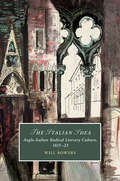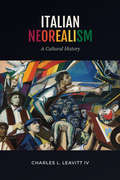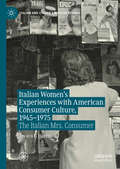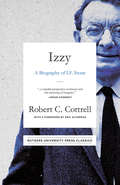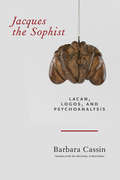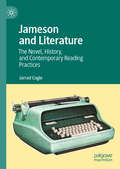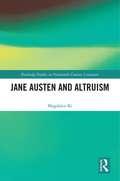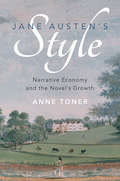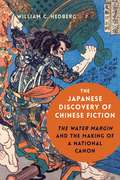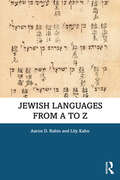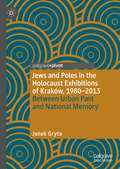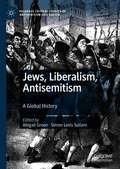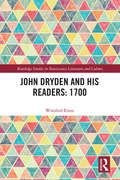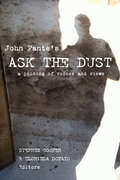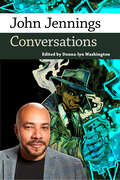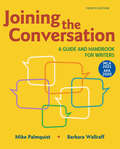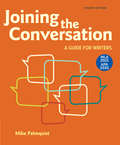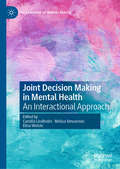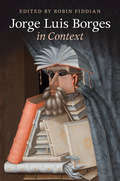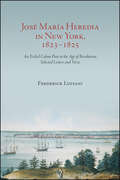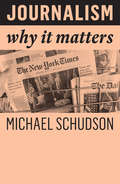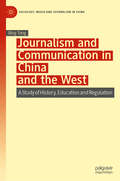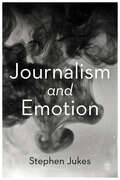- Table View
- List View
The Italian Idea: Anglo-Italian Radical Literary Culture, 1815–1823 (Cambridge Studies in Romanticism #128)
by Will BowersFrom 1815 to 1823 the Italian influence on English literature was at its zenith. While English tourists flocked to Italy, a pervasive Italianism coloured many facets of London life, including poetry, periodicals, translation, and even the Queen's trial of 1820. In this engaging study Will Bowers considers this radical interaction by pursuing two interrelated analyses. The first examines the Italian literary and political ideas absorbed by Romantic poets, particularly Lord Byron, Leigh Hunt, and Percy Bysshe Shelley. The second uncovers the ambassadorial role played in London by Italians, such as Serafino Buonaiuti and Ugo Foscolo, who promoted a revolutionary idea of their homeland and its literature, particularly Dante's Commedia. This dual-perspective study reveals the cosmopolitan challenge to Regency mores embodied in both the work of Italian literary exiles in London and the English poetic engagement with Italy.
Italian Neorealism: A Cultural History (Toronto Italian Studies)
by Charles L. Leavitt IVNeorealism emerged as a cultural exchange and a field of discourse that served to shift the confines of creativity and revise the terms of artistic expression not only in Italy but worldwide. If neorealism was thus a global phenomenon, it is because of its revolutionary portrayal of a transformative moment in the local, regional, and national histories of Italy. At once guiding and guided by that transformative moment, neorealist texts took up, reflected, and performed the contentious conditions of their creation, not just at the level of narrative content but also in their form, language, and structure. Italian Neorealism: A Cultural History demonstrates how they did so through a series of representative case studies. Recounting the history of a generation of artists, this study offers fundamental insights into one of the most innovative and influential cultural moments of the twentieth century.
Italian Women's Experiences with American Consumer Culture, 1945–1975: The Italian Mrs. Consumer (Italian and Italian American Studies)
by Jessica L. HarrisThis book analyzes the spread of American female consumer culture to Italy and its influence on Italian women in the postwar and Cold War periods, eras marked by the political, economic, social, and cultural battle between the United States and Soviet Union. Focusing on various aspects of this culture—beauty and hygiene products, refrigerators, and department stores, as well as shopping and magazine models—the book examines the reasons for and the methods of American female consumer culture’s arrival in Italy, the democratic, consumer capitalist messages its products sought to “sell” to Italian women, and how Italian women themselves reacted to this new cultural presence in their everyday lives. Did Italian women become the American Mrs. Consumer? As such, the book illustrates how the modern, consuming American woman became a significant figure not only in Italy’s postwar recovery and transformation, but also in the international and domestic cultural and social contests for the hearts and minds of Italian women.
Izzy: A Biography of I. F. Stone
by Robert C. CottrellThis is the classic story of the life and times of I. F. “Izzy” Stone. Robert Cottrell weaves together material from interviews, letters, archival materials, and government documents, and Stone’s own writings to tell the tale of one of the most significant journalists, intellectuals, and political mavericks of the twentieth century. The story of I. F. Stone is the tale of the American left over the course of his lifetime, of liberal and radical ideals which carried such weight throughout the twentieth century, and of journalism of the politically committed variety. Now available in a handsome new Rutgers University Press Classic edition, it is an examination of the life and career of a gregarious yet frequently grumpy loner who became his nation’s foremost radical commentator provides a window through which to examine American radicalism, left-wing journalism, and the evolution of key strands of Western intellectual thought in the twentieth century.
Jacques the Sophist: Lacan, Logos, and Psychoanalysis
by Barbara CassinSophistry, since Plato and Aristotle, has been philosophy’s negative alter ego, its bad other. Yet sophistry’s emphasis on words and performativity over the fetishization of truth makes it an essential part of our world’s cultural, political, and philosophical repertoire. In this dazzling book, Barbara Cassin, who has done more than anyone to reclaim a mode of thought that traditional philosophy disavows, shows how the sophistical tradition has survived in the work of psychoanalysis.In a highly original rereading of the writings and seminars of Jacques Lacan, together with works of Freud and others, Cassin shows how psychoanalysis, like the sophists, challenges the very foundations of scientific rationality. In taking seriously equivocations, jokes, and unfinishable projects of interpretation, the analyst, like the sophist, allows performance, signifier, and inconsistency to reshape truth.This witty, brilliant tour de force celebrates how psychoanalysts have become our culture’s key dissidents and register, in Lacan’s words, “the presence of the sophist in our time.”
James Joyce and the Jesuits
by Michael MayoJames Joyce was educated almost exclusively by the Jesuits; this education and these priests make their appearance across Joyce's oeuvre. This dynamic has never been properly explicated or rigorously explored. Using Joyce's religious education and psychoanalytic theories of depression and paranoia, this book opens radical new possibilities for reading Joyce's fiction. It takes readers through some of the canon's most well-read texts and produces bold, fresh new readings. By placing these readings in light of Jesuit religious practice - in particular, the Spiritual Exercises all Jesuit priests and many students undergo - the book shows how Joyce's deepest concerns about truth, literature, and love were shaped by these religious practices and texts. Joyce worked out his answers to these questions in his own texts, largely by forcing his readers to encounter, and perhaps answer, those questions themselves. Reading Joyce is a challenge not only in terms of interpretation but of experience - the confusion, boredom, and even paranoia readers feel when making their way through these texts.
James Joyce in Zurich: A Guide
by Andreas FischerThis book offers a comprehensive account of James Joyce and Zurich, one of the four cities (including Dublin, Trieste and Paris) in which he spent significant parts of his life. As a refugee during World War I, Joyce wrote a substantial part of Ulysses in Zurich and subsequently visited the city regularly during the 1930s. Finally, a refugee for the second time, he died there on 13 January 1941 and is buried in Fluntern Cemetery. This guide is conceived both as a book that may be read in its entirety or consulted selectively for specific information. An introduction and three chapters, Joyce in Zurich, Zurich in Joyce and Zurich after Joyce, are followed by sixty alphabetically ordered articles on people, places, institutions and events relevant to Joyce during his time in Zurich. Linked by cross-references and an index, they provide a rich, kaleidoscopic view of Joyce’s Zurich.
Jameson and Literature: The Novel, History, and Contemporary Reading Practices
by Jarrad CogleThis book demonstrates how Fredric Jameson’s understanding of the novel form has heavily influenced his work as a critical theorist. It contends that Jameson’s idiosyncratic engagements with the literary canon have had a major impact on his theoretical frameworks, particularly in his sense of historical change. The book investigates Jameson’s predominant literary interests in chapters focusing on realism, modernism, postmodernism and genre fiction. These readings provide fresh perspectives on Jameson’s career, ones that look beyond his most famous contributions to cultural theory and interpretive practice. Through this work, the book also rethinks the criticism that has surrounded Jameson, while suggesting ways in which his literary interpretation remains useful for contemporary reading practices.
Jane Austen and Altruism (Routledge Studies in Nineteenth Century Literature)
by Magdalen KiJane Austen and Altruism identifies a compelling theme, namely, the view that Jane Austen propounds a rigorous, boundary-sensitive model of altruism that counters the human propensity to selfishness and promotes the culture of cooperation. In her days, altruism was commonly known as "benevolence", "charity," or "philanthropy", and these concepts overlap with Auguste Comte’s later definition of altruism as "otherism". This volume argues that Austen’s thinking co-opts the evolutionary idea that altruism is seldom truly pure, egoism cannot be eradicated, and boundless group altruism is not sustainable. However, given that she comes from a naval and clergy family, she witnesses the power of wartime patriotism, the Evangelical revival, the Regency culture of politeness, and the sentimental novels. In her novels, she locates human relationships along an altruism continuum that ranges from enlightened selfishness to pathological altruism. Unconditional love is hard to find, but empathy, kin altruism, reciprocal exchange, and group altruism are key to the formation of self-identity, family, community and the nation state.
Jane Austen's Style: Narrative Economy and the Novel's Growth
by Anne TonerJane Austen is renowned for the economy of her art: for the close focus of her romantic plots and the precision of her writing style. Exploring that economy stylistically and structurally, this book traces Austen's keen interest in narrative form. Anne Toner pinpoints techniques that are fundamental to the distinctiveness of Austen's fiction, many of which have been little explored to date. Toner argues that Austen's conciseness in terms of plotting, narrative description and in the depiction of dialogue also contributed to her innovations in representing thought, expanding the novel's capacity to depict consciousness. Narrative and rhetorical features are presented clearly and accessibly and will open up new ways of thinking about prose style with implications for the study of fiction beyond Austen's own.
The Japanese Discovery of Chinese Fiction: The Water Margin and the Making of a National Canon
by William C. HedbergThe classic Chinese novel The Water Margin (Shuihu zhuan) tells the story of a band of outlaws in twelfth-century China and their insurrection against the corrupt imperial court. Imported into Japan in the early seventeenth century, it became a ubiquitous source of inspiration for translations, adaptations, parodies, and illustrated woodblock prints. There is no work of Chinese fiction more important to both the development of early modern Japanese literature and the Japanese imagination of China than The Water Margin.In The Japanese Discovery of Chinese Fiction, William C. Hedberg investigates the reception of The Water Margin in a variety of early modern and modern Japanese contexts, from eighteenth-century Confucian scholarship and literary exegesis to early twentieth-century colonial ethnography. He examines the ways Japanese interest in Chinese texts contributed to new ideas about literary canons and national character. By constructing an account of Japanese literature through the lens of The Water Margin’s literary afterlives, Hedberg offers an alternative history of East Asian textual culture: one that focuses on the transregional dimensions of Japanese literary history and helps us rethink the definition and boundaries of Japanese literature itself.
Jewish Languages from A to Z
by Lily Kahn Aaron D. RubinJewish Languages from A to Z provides an engaging and enjoyable overview of the rich variety of languages spoken and written by Jews over the past three thousand years. The book covers more than 50 different languages and language varieties. These include not only well-known Jewish languages like Hebrew, Yiddish, and Ladino, but also more exotic languages like Chinese, Esperanto, Malayalam, and Zulu, all of which have a fascinating Jewish story to be told. Each chapter presents the special features of the language variety in question, a discussion of the history of the associated Jewish community, and some examples of literature and other texts produced in it. The book thus takes readers on a stimulating voyage around the Jewish world, from ancient Babylonia to 21st-century New York, via such diverse locations as Tajikistan, South Africa, and the Caribbean. The chapters are accompanied by numerous full-colour photographs of the literary treasures produced by Jewish language-speaking communities, from ancient stone inscriptions to medieval illuminated manuscripts to contemporary novels and newspapers. This comprehensive survey of Jewish languages is designed to be accessible to all readers with an interest in languages or history, regardless of their background—no prior knowledge of linguistics or Jewish history is assumed.
Jews and Poles in the Holocaust Exhibitions of Kraków, 1980–2013: Between Urban Past and National Memory
by Janek GrytaThis book offers a unique approach to memory studies by focusing on local memory work conducted across the divide of the fall of Communism, whereas other histories have consistently used 1989 as a watershed moment. By examining the ways in which the Holocaust has been exhibited in Kraków, it investigates the impact local memory work has had on Polish collective memory and problematizes the importance of the fall of Communism for memory work. Using the Polish case study, it contributes to international debates on the nature of urban memory. It brings to the fore the role of mid-ranking governmental and municipal activists for local remembrance, investigates the relationship between the form and the content of the exhibitions, and highlights the importance of authenticity and emotional evocations for Holocaust remembrance. In particular, it focuses on the emergence of cosmopolitan memory of the Holocaust, a process with local, Kraków, sources.
Jews, Liberalism, Antisemitism: A Global History (Palgrave Critical Studies of Antisemitism and Racism)
by Abigail Green Simon Levis Sullam“This is a timely contribution to some of the most pressing debates facing scholars of Jewish Studies today. It forces us to re-think standard approaches to both antisemitism and liberalism. Its geographic scope offers a model for how scholars can “provincialize” Europe and engage in a transnational approach to Jewish history. The book crackles with intellectual energy; it is truly a pleasure to read.”- Jessica M. Marglin, University of Southern California, USAGreen and Levis Sullam have assembled a collection of original, and provocative essays that, in illuminating the historic relationship between Jews and liberalism, transform our understanding of liberalism itself. - Derek Penslar, Harvard University, USA“This book offers a strikingly new account of Liberalism’s relationship to Jews. Previous scholarship stressed that Liberalism had to overcome its abivalence in order to achieve a principled stand on granting Jews rights and equality. This volume asserts, through multiple examples, that Liberalism excluded many groups, including Jews, so that the exclusion of Jews was indeed integral to Liberalism and constitutive for it. This is an important volume, with a challenging argument for the present moment.”- David Sorkin, Yale University, USAThe emancipatory promise of liberalism – and its exclusionary qualities – shaped the fate of Jews in many parts of the world during the age of empire. Yet historians have mostly understood the relationship between Jews, liberalism and antisemitism as a European story, defined by the collapse of liberalism and the Holocaust. This volume challenges that perspective by taking a global approach. It takes account of recent historical work that explores issues of race, discrimination and hybrid identities in colonial and postcolonial settings, but which has done so without taking much account of Jews. Individual essays explore how liberalism, citizenship, nationality, gender, religion, race functioned differently in European Jewish heartlands, in the Mediterranean peripheries of Spain and the Ottoman empire, and in the North American Atlantic world.
John Dryden and His Readers: 1700 (Routledge Studies in Renaissance Literature and Culture)
by Winifred ErnstDryden at the end of his life was admired, perhaps even beloved, by many in England, and his greatest skill over his long career—his controlled detachment—uniquely positioned him to write of both history and politics in 1700. His narrative poetry was popular among Whigs and Tories, women and men, Ancients and Moderns, and his imitations suggest historical connections between the War of the Roses, the Civil War, and the Revolution of 1688. All of these events combined easily in the minds of Dryden’s contemporaries, and his fables, fraught with conflicted loyalties and family strife not unlike a nation divided, may have caught and compelled his readers in a way that was different from other miscellanies: Dryden may have articulated in beautiful verse the emotions of many in the midst of enormous historical change. Fables is a pivotal cultural text urging national unity through its embrace of competing voices.
John Fante's Ask the Dust: A Joining of Voices and Views (Critical Studies in Italian America)
by Miriam Amico Charles Bukowski Stephen Cooper Giovanna Di Lello John Fante Valerio Ferme Teresa Fiore Daniel Gardner Robert Guffey Philippe Garnier Ryan Holiday Jan Louter Chiara Mazzucchelli Meagan Meylor J’aime Morrison Nathan Rabin Alan Rifkin Suzanne Roszak Danny Shain Robert Towne Joel WilliamsThis volume assembles for the first time a staggering multiplicity of reflections and readings of John Fante’s 1939 classic, Ask the Dust, a true testament to the work’s present and future impact.The contributors to this work—writers, critics, fans, scholars, screenwriters, directors, and others—analyze the provocative set of diaspora tensions informing Fante’s masterpiece that distinguish it from those accounts of earlier East Coast migrations and minglings. A must-read for aficionados of L.A. fiction and new migration literature, John Fante’s “Ask the Dust”: A Joining of Voices and Views is destined for landmark status as the first volume of Fante studies to reveal the novel’s evolving intertextualities and intersectionalities.Contributors: Miriam Amico, Charles Bukowski, Stephen Cooper, Giovanna DiLello, John Fante, Valerio Ferme, Teresa Fiore, Daniel Gardner, Philippe Garnier, Robert Guffey, Ryan Holiday, Jan Louter, Chiara Mazzucchelli, Meagan Meylor, J’aime Morrison, Nathan Rabin, Alan Rifkin, Suzanne Manizza Roszak, Danny Shain, Robert Towne, Joel Williams
John Jennings: Conversations (Conversations with Comic Artists Series)
by Donna-Lyn WashingtonJohn Jennings (b. 1970) is perhaps best known for his collaboration with Damian Duffy on the New York Times bestseller and Eisner Award–winning graphic novel adaptation of Octavia Butler’s Kindred. However, Jennings is also a graphic designer and comic book scholar who, throughout his career, has conducted several interviews that shed light on the importance of Black Speculative narratives. The most enlightening of his interviews are brought together in John Jennings: Conversations.As a collective these interviews explore folklore, systemic racism, his Mississippi roots, and the phrase Jennings cocreated, the Ethnogothic. Jennings discusses the necessity for black heroes, not just for the sake of diversity, but for inclusiveness, touching on the conventions he has cofounded, such as the Schomburg Center’s Black Comic Book Festival in Harlem. He addresses the struggle to be financially compensated for work, and he speaks at length about how being a professor informs his craft where he continues to examine black stereotypes in popular culture with courses of his own design. As a group the interviews in John Jennings: Conversations give a picture of a black man forging a way where comic books have afforded him a means to carve out an important space for people of color.
Joining the Conversation: A Guide and Handbook for Writers with 2020 APA and 2021 MLA Updates
by Mike Palmquist Barbara WallraffThis ebook has been updated to provide you with the latest guidance on documenting sources in MLA style and follows the guidelines set forth in the MLA Handbook, 9th edition (April 2021).Grounded in the best practices of effective writing instruction, Joining the Conversation’s rhetorical approach teaches students the key critical thinking skills they will draw on as they begin to explore and respond thoughtfully to the complex conversations around them. From reflective and informative to analytical and persuasive writing, chapters follow real student writers as they find a conversation, develop, revise, and document their writing. Thoroughly revised, the fourth edition includes new student projects and more support for academic reading, critical thinking, and assessing credibility and bias.
Joining the Conversation with 2020 APA and 2021 MLA Updates: A Guide for Writers
by Barbara Wallraff Mike PalmquistThis ebook has been updated to provide you with the latest guidance on documenting sources in MLA style and follows the guidelines set forth in the MLA Handbook, 9th edition (April 2021).Grounded in the best practices of effective writing instruction, Joining the Conversation’s rhetorical approach teaches students the key critical thinking skills they will draw on as they begin to explore and respond thoughtfully to the complex conversations around them. From reflective and informative to analytical and persuasive writing, chapters follow real student writers as they find a conversation, develop, revise, and document their writing. Thoroughly revised, the fourth edition includes new student projects and more support for academic reading, critical thinking, and assessing credibility and bias.
Joint Decision Making in Mental Health: An Interactional Approach (The Language of Mental Health)
by Camilla Lindholm Melisa Stevanovic Elina WeisteThis volume studies joint decision making in mental health care contexts through an in-depth examination of the negotiations of power and authority at the level of turn-by-turn sequential unfolding of interaction. Bringing together research at the intersection of mental health, discourse and conversation analysis it examines a wide range of settings including chronic psychiatric visits, rehabilitation meetings, occupational therapy encounters and cognitive behavioral therapy appointments. It presents a series of studies which reveal in close detail the joint decision-making processes in these critical encounters by using naturally occurring video-recorded interactions from a range of health service settings as data. In so doing, it sheds light on the interactional practices of health care workers that may facilitate or discourage client participation in joint decision-making processes. The book will provide important insights for academics and practitioners working in the fields of psychology, psychotherapy, applied linguistics, nursing, social work and rehabilitation; and in particular for those specializing in psychiatry and mental health.
Jorge Luis Borges in Context (Literature in Context)
by Robin FiddianJorge Luis Borges (1899–1986) is Argentina's most celebrated author. This volume brings together for the first time the numerous contexts in which he lived and worked; from the history of the Borges family and that of modern Argentina, through two world wars, to events including the Cuban Revolution, military dictatorship, and the Falklands War. Borges' distinctive responses to the Western tradition, Cervantes and Shakespeare, Kafka, and the European avant garde are explored, along with his appraisals of Sarmiento, gauchesque literature and other strands of the Argentine cultural tradition. Borges' polemical stance on Catholic integralism in early twentieth-century Argentina is accounted for, whilst chapters on Buddhism, Judaism and landmarks of Persian literature illustrate Borges's engagement with the East. Finally, his legacy is visible in the literatures of the Americas, in European countries such as Italy and Portugal, and in the novels of J. M. Coetzee, representing the Global South.
José María Heredia in New York, 1823–1825: An Exiled Cuban Poet in the Age of Revolution, Selected Letters and Verse
by Frederick LucianiThis volume offers the most complete English translation to date of the prose and poetry of José María Heredia (b. Cuba, 1803; d. Mexico, 1839), focusing on Heredia's political exile in the United States from November 1823 to August 1825. Frederick Luciani's introduction offers a complete biographical sketch that discusses the complications of Heredia's life in exile, his conflicted political views, his significance as a travel writer and observer of life in the United States, and his reception by nineteenth-century North American writers and critics. The volume includes thoroughly annotated letters that Heredia wrote to family and friends in Cuba, describing his struggles and adventures living among other young expatriates in New York City—fellow conspirators in a failed plot to overthrow Spanish rule on the island. His travel letters, especially those that describe his trip to the Niagara frontier in 1824 along the Hudson River and the Erie Canal, offer discerning reflections on American landscapes, technological advances, political culture, and social customs. The volume also offers translations of the verse that Heredia composed during his New York exile, in which he gave impassioned voice to Cuba's struggle for independence from Spain, and which reflected the emerging Romantic sensibilities in Spanish-language poetry. With accurate, clear translations, this volume serves as an introduction to a figure who is enshrined in the canon of Latin American literature, but scarcely known to Anglophone readers.
Journalism: Why It Matters (Why It Matters)
by Michael SchudsonDespite the criticisms that have been leveled at news organizations in recent years and the many difficulties they face, journalism matters. It matters, argues Schudson, because it orients people daily in the complex and changing worlds in which they live. It matters because it offers a fact-centered, documented approach to pertinent public issues. It matters because it keeps watch on the powerful, especially those in government, and can press upon them unpleasant truths to which they must respond. Corruption is stemmed, unwise initiatives stopped, public danger averted because of what journalists do. This book challenges journalists to think hard about what they really do. It challenges skeptical news audiences to be mindful not only of media bias but also of their own biases and how these can distort their perception. And it holds out hope that journalism will be for years to come a path for ambitious, curious young people who love words or pictures or numbers and want to use them to improve the public conversation in familiar ways or in ways yet to be imagined.
Journalism and Communication in China and the West: A Study of History, Education and Regulation (Sociology, Media and Journalism in China)
by Bing TongThis book sheds new light on the study of journalism and communication, considering why and how journalism is studied in the 21st century. It notably offers both an international and interdisciplinary comparison of journalism and communication, examining the history of Chinese and Western journalism and addressing the similarities and differences between them. Focusing on the education and training of future journalists, it also provides a comprehensive study of news coverage systems in China and in Western countries, including the processing of news sources, attitudes towards news communication and comparative communication scholarship. Researchers of media and journalism will find this a key read, as well as practicing journalists and students of journalism.
Journalism and Emotion
by Professor Stephen Jukes"Indispensable.... for anyone who cares about journalism." - Professor Karin Wahl-Jorgensen How can we understand the complex relationship between journalism and emotion? In a world of live-streamed terror, polarised political debates and fake news, emotion has become central to our understanding of contemporary journalism. Including interviews with leading journalists throughout, Journalism and Emotion critically explores the impact of this new affective media environment, not just on the practice of journalism, but also the lived experience of journalists themselves. Bringing together theory and practice, Stephen Jukes explores: The history of objectivity and emotion in journalism, from pre-internet to digital. The &‘emotionalisation&’ of culture in today&’s populist media landscape. The blurring of boundaries between journalism and social media content. The professional practices of journalists working with emotive material. The mental health risks to journalists covering traumatic stories. The impact on journalists handling graphic user-generated content. In today&’s interactive, interconnected and participatory media environment, there is more emotive content being produced and shared than ever before. Journalism and Emotion helps you make sense of this, explaining how emotion is mobilised to influence public opinion, and how journalists themselves work with and through emotional material.
